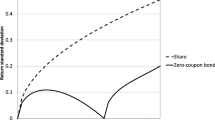Abstract
This study identifies profitability patterns and their determinants in the global interest rate derivatives market. Although this market is the world’s largest financial market in terms of nominal value, there has been basically no academic research on profitability owing to missing data. To address this problem, a new analytical method has been developed. Using this new method, the study shows that interest rate derivatives have been a substantial source of profitability that have netted a total average annual profit of more than USD 82 billion for banks since 2009. Furthermore, the study shows that counterparty type, market position (i.e. being one of the Top 5 banks), and trade currency are determinants of the profitability of a trade. For other features of a trade, such as duration or notional amount, no correlation with profitability is found. Finally, the impact of changes of the market structure on profitability driven by regulatory initiatives is discussed qualitatively.
Similar content being viewed by others
Notes
Gross market values are calculated as the sum of the total gross positive market value of contracts and the absolute value of the gross negative market value of contracts. In order to calculate profitability, separate reporting of positive and negative market values would be necessary as the difference of these two equals the market value of the respective portfolio.
The total notional of all open interest rate derivatives of these 19 banks as of 31.12.2013 is USD 618 trillion (see supplementary of Appendix 4a). The total worldwide market equals USD trillion 689.5 (USD 564.7 trillion market size reported by BIS (see supplementary of Appendix 3) + USD 104.1 trillion interdealer transaction counted only once by BIS (see supplementary of Appendix 3) adjusted for 97% market coverage of BIS reporting)
Positions with a positive market value of USD 10,287.6 million and other positions with a negative market value of USD 9,968.5 million
Non–reporting dealers
All currencies except of USD, EUR and GBP
BNP, Royal Bank of Scotland, Barclays, Citigroup Credit Suisse, and Bank of America
Calculated as (margin of market leaders (3.43 bp + 2.39 bp)—margin of smaller banks (1.56 bp + 0.37 bp))/(2 \(\times \) 2) (Effect for 2 years + double counting effect)
In this paper, “value generation” is defined as net position (derivative assets–derivative liabilities) for CCP-cleared transactions as the total of all CCP-cleared transaction of all banks is 0 (zero-sum game). For bilaterally-cleared transaction (mainly transactions with other financial institutions and non-financial customers), “value creation” is defined as profit margin above the average margin of all reporting dealers (1.93 basis points)
References
Acharya, V., Cooley, T., Richardson, M., & Walter, I. (2010). Regulating wall street: The Dodd-Frank act and the new architecture of global finance. New York: Wiley Publishing.
Atkeson, A., Eisfeldt, A., & Weill, P. (2013). The market for OTC derivatives. Working Paper, UCLA.
Atkeson, A., Eisfeldt, A., & Weill, P. (2014). Entry and exit in OTC derivatives markets. Working Paper, UCLA.
Bank For International Settlements. (2013a). Triennial Central Bank Survey Derivatives positions at end-June 2013. Technical Report, Bank for International Settlements.
Bank For International Settlements. (2013b). Triennial Central Bank Survey OTC interest rate derivatives turnover in April 2013: preliminary global results. Technical Report, Bank for International Settlements.
Bank For International Settlements. (2014). BIS Quarterly Review: December 2014. Technical Report, Bank for International Settlements.
Bank For International Settlements. (2016). OTC derivatives market activity in the second half of 2015. Technical Report, Bank for International Settlements.
Cont, R. & Kokholm, T. (2011). Central clearing of OTC derivatives bilateral vs. multilateral netting. Working Paper.
Duffie, D., & Zhu, H. (2011). Does a central clearing counterparty reduce counterparty risk? Review of Asset Pricing Studies, 1, 74–95.
Emm, E., & Gay, G. (2005). The global market for OTC derivatives: An analysis of dealer holdings. Journal of Futures Markets, 25(1), 39–77.
International Swap Dealer Association (ISDA) (2013). ISDA Margin Survey 2013. ISDA.
Kyle, A., & Viswanathan, S. (2008). How to define illegal price manipulation. American Economic Review, 98(2), 274–279.
Office of the Comptroller of the Currency. (2016). OCC’s Quarterly Report on Bank Trading and Derivatives Activities Fourth Quarter 2015. Technical Report, Office of the Comptroller of the Currency.
Switzer, L. & Sheahan-Lee, E. (2013). The Impact of Dodd-Frank Regulation of OTC Derivative Markets and the Volcker Rule on International Versus US Banks: New Evidence, working Paper.
World Federation of Exchange Members (2015). Monthly Reports. http://www.world-exchanges.org/statistics/monthly-reports. Retrieved 21, Feb 2015.
Author information
Authors and Affiliations
Corresponding author
Electronic supplementary material
Below is the link to the electronic supplementary material.
Rights and permissions
About this article
Cite this article
Meyer, R. Profitability patterns in the interest rate derivatives market. Rev Deriv Res 20, 231–254 (2017). https://doi.org/10.1007/s11147-017-9129-3
Published:
Issue Date:
DOI: https://doi.org/10.1007/s11147-017-9129-3




